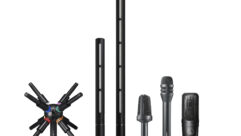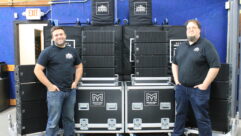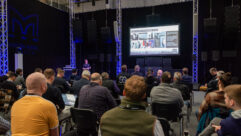Full steam aheadThe General Jackson Riverboat at Opryland USA neededan audio overhaul for both music and safety.
Nov 20, 1996 12:00 PM,
Biff McGillicuttyMcGillicutty is a free-lance writer in the sound and video industry. Photos courte
The Cumberland River flows through Nashville TN, home of the world-famous Opryland USA and one of its prize attractions, the General Jackson, a turn-of-the-century paddlewheel riverboat that ferries guests from its moor at Opryland USA along the river for a splendid river view of downtown Nashville.
The five-level ship, which runs up to five cruises a day, depending on the season, is 300 feet (91 m) long and about 75 feet (23 m ) wide at its widest point, with a capacity of more than 2,000 people. It has three major live performance spaces, anchored by the beautiful and ornate Victorian Theater.
The General Jackson recently underwent a major audio upgrade; the importance of this high-profile venue coupled with the enormous amount of passengers yearly and the rugged environment made this sound installation intricate. Not only are the program material and its presentation important, but a vessel carrying this many people must adhere to strict safety regulations.
“The previous deficiency of the General Jackson was numerous small drivers tapped at low wattages under the theory of better coverage by numbers, resulting in less than premium transducers, rather than by horsepower,” said Mark Ramsey, head of production sound services at Opryland USA. “The captains argued that they had no horsepower. When we began to look at the aspects of horsepower and everything that comes with it, the question became, do we want raw horsepower alone or musical horsepower? We could have saved a lot of money going with the former over the latter, but because of the importance of music at Opryland, the new system had to incorporate both.”
Therefore, two separate, distinct functions were addressed: emergency paging and full-blown, in-your-face entertainment. Juggling the opposing parameters and the stringent Coast Guard regulations made it an extreme challenge to design and install a system within the time frame and budget provided. The time frame was most crucial; only a seven-day window was available in which to complete the task.
Paging and background musicIt is unacceptable for a patron to be unable to hear or interpret a message from the captain under emergency management conditions anywhere on the boat. The goal on the deck level for paging was 110 dB at 1 k, and the system also had to reach 93 dB at 1 k on each shore. The river is 350 feet (91 m) to 400 feet (121 m) wide, and the captain’s instructions needed to be intelligible from either side of the river in an emergency situation.
The two paging positions on the General Jackson are in the Pilot House and the boat operations office. When the pilot goes to his microphone he can chose one of two buttons: one that shuts down everything, allowing him to speak to the entire boat, and one that allows him to talk to the crew areas only. When he presses the all-call button, it sends all eight Ivie relays into page mode; one of the Ivie relays then feeds the Crown IQ in the Victorian Theater. This overrides the Martin W3 front-of-house array so the captain can interrupt the live entertainment.
The paging position in the boat operations office works similarly on a switch system. The three switches in the sequence are followed by a key turn. The first two switches reach, respectively, Heritage Hall, an 80-person bar and grill used for private functions and guest entertainment, and the Hurricane Deck, a live performance venue on the boat’s top deck. The third switch reaches the entire ship, with the exception of the Victorian Theater. The fourth step and only key turn in the sequence is the Victorian Theater. Having all three switches up and the key turned is essentially the same as all call, and only the captain has the authority to use it.
This brings us to the background music area and how it relates to paging. Opryland is a celebration of country music, its lifestyle and history. The program material is really not background music; it’s delivered to Opryland’s guests in a foreground fashion. The goal is a very musical foreground system with appropriate dispersion control for each zone of the General Jackson.
The outer deck areas are divided into 15 zones, with 800 W available per zone. The new system uses 44 Tannoy Arena C-60 loudspeakers, which have proprietary, point source, ICT (Inductive Coupling Technology) drive units with a 60 W internally mounted, multitap transformer. The system also uses a total of 20 Tannoy CPA 12 loudspeakers custom-made for this application to meet Coast Guard regulations for vessels carrying more than 1,000 passengers. They are made of a material Tannoy refers to as nunya, wood painted with a marine-grade epoxy paint. The drivers are specially treated, and custom metal grilles with treated foam are added for complete weatherization. The CPA 12s in this part of the installation are 70 V and use Tannoy’s 60 W transformers and patented point-source, Dual Concentric technology.
The larger diameter CPA 12s are used where additional volume levels are required or in places in which it would be difficult to place a larger number of smaller diameter transducers.
Jeff Lindsay, system engineering supervisor at Opryland, said, “The CPA 12s are very accurate musically, providing studio-quality reproduction, and are second to none from a speech intelligibility standpoint. These same custom loudspeakers are also used throughout the theme park, providing us with a proven, successful model on which to base our expectations.”The background music and paging system is controlled by eight Ivie 2300 control heads and powered by a total of eight Crown CT 1600 70 V amplifiers. The more mechanical – using relays instead of being computer-based – Ivie front ends are used in the paging system because they seem to cope better with power fluctuation than the Crown IQ system running the Victorian Theater live performances.
“This segment of the installation was certainly the most difficult because the new system replaced outdated, exposed metal enclosures that housed a large number of small transducers,” said David Bates, the project’s installation supervisor. “The previous system was replaced by fewer loudspeakers, which improved dispersion coverage, fidelity and sound-pressure levels. This meant using existing wiring and devising an ingenious way of affixing the Tannoy Arenas to the outer deck ceilings so the existing wiring already encased in weatherproof materials could be terminated properly.”
Against the clockThe time window was only one week. Because of a variety of circumstances, the original bracketing scheme for the 44 Arena loudspeakers for the outer deck areas was abandoned, and no contingency plan existed.
“Our project procurement guru Todd Tillemans and I found ourselves downtown Nashville at Braid Electric,” said Mark Ramsey, head of Opryland’s production sound services. “Braid has an enormous 28,000 ft2 (2,601 m2) plus warehouse with row after row of every electrical part imaginable. We were trying to come up with something to achieve our goal.
“We were using the existing marine-grade cable coming to an octagonal electrical junction box that isn’t made anymore. We had to find cap covers for them to match the existing screw holes, which proved to be impossible, and devise a way to achieve at least two inches of standoff for wiring and maintenance accessibility. With some improvisation on the cap covers, we were able to overcome this problem. We couldn’t quickly find any actual standoffs that ran two inches (51 mm), so instead we bought oversized All-Thread zinc couplers. We ran the 6 mm — 3.5 inch (89 mm) screws into them using the coupler as a standoff. We compression-fitted all components on a 90° ratchet directly into the junction box. In the end, we solved this problem, which seriously threatened the time window, very effectively.”
For the CPA 12s bracketing scheme, Ramsey used 2 inch (51 mm) square steel tubing and 1/4 inch (6 mm) steel plate cut into 2 inch — 8 inch (51 mm — 203 mm) strips. Dog ears were welded onto the bracket so that the loudspeaker fit in between. The dog ears were drilled twice, once to support the main weight of the loudspeaker and once for a compression fitting against the loudspeaker itself. This scheme eliminated left-right play, allowing only vertical positioning. The brackets were then welded to the boat’s steel structure.
The program material for the entire system is driven with a single Sony five-disc carousel CD player. All CDs are made at Opryland and contain 72 minutes of current, charting country music. Because of the system’s musical accuracy, Ramsey and company had to remaster all material. The loudspeaker inadequacies in the previous system had required a lot of doctoring at the mastering stage to make it sound right. The new system doesn’t require that, saving time and money in that stage of production.
The waiting area and staff areasThe waiting area, a large gazebo-type structure and covered walkway leading down to the ship, was also substantially upgraded. For the past eight years, only eight Electro-Voice S40s loudspeakers covered this large area. This system was replaced with eight Tannoy Arena C-60s in the gazebo area and eight in the covered walkway. The result was roughly 102 dB at 1 k for the entire zone, which improved boarding efficiency.
The large galley, boiler room and general staff areas were also similarly upgraded to allow the crew to hear the captain’s instructions better.
The Victorian TheaterThe Victorian Theater, which features a six-piece band in the daytime and a 10-piece orchestra at night, underwent an important audio changeover. As the main centerpiece of the General Jackson, with a 1,000-person capacity, it is vitally important that sound be clean, clear and seamless throughout the theater. It is equally important that the sightlines be completely unobstructed. With both of those points in mind, the designers tucked the front-of-house array neatly behind an ornate screen above the stage.
An array of three Martin Audio W3 loudspeakers was chosen to provide front-of-house sound. The W3 is a compact, three-way loudspeaker featuring constant-Q, 65° horizontal dispersion and a maximum continuous sound-pressure level of 125 dB. “We now have all the fidelity and headroom we require with tightly controlled dispersion. The audience both in the main seating area and the balcony area gets a true representation of what’s happening on stage,” Ramsey said.
Two Crest 3001 amplifiers power the front-of-house array. Delay is handled by 28 Electro-Voice S-40 loudspeakers from the previous system placed throughout the balcony and rear main seating area. These are powered by four QSC 1500 amplifiers from the previous system. The Victorian Theater system is controlled by a Crown SMX-6 IQ system tied into the emergency paging system.
The Victorian Theater now has a great sounding, flexible audio environment that deals effectively with the variety of entertainment that graces its stage.
The Hurricane DeckThe Hurricane Deck, with a 200-person capacity, is on the top deck of the boat and is covered with a canopy. A six-piece country band entertains for the duration of the cruise after the main performance in the Victorian Theater. This area required a simple but effective sound-reinforcement system. Two of the Custom CPA 12s are mounted on the outside corners of the lighting truss facing the audience; two more are mounted on the inside facing the band as monitors. The high level of speech intelligibility, musicality and 90° dispersion provided by the CPA 12s are ideal for the outdoor venue.The outside perimeter of the deck houses 12 Tannoy CPA 12s that are part of the background-emergency paging system and are not used during the live performance.
The Pilot HouseThe captains have at their disposal a system consisting of four Tannoy Arena loudspeakers and a Tannoy Arena subwoofer. The sub is built into a bench seat at the rear of the pilot house. The concealed placement makes the low-frequency source difficult to isolate, creating a seamless, full-frequency sound stage. This system is driven by a Sony CD player and is isolated from the rest of the system for the captain’s exclusive use.
Finishing up”The General Jackson, the world’s largest riverboat and a major attraction for Opryland USA, required specific focus and finesse,” Ramsey said. “That’s why it was so important for us to first design a dynamic, articulate sound system that provides excellent entertainment value while meeting the rigorous Coast Guard marine requirements. Second, and most important, all systems were installed in the time frame allotted. With the ingenuity and expertise of our sound team coupled with support from our suppliers, we achieved our goals.”The last two days of the installation consisted of logic sequence testing to ensure that everything was wired properly and zones were performing to the original design specifications. Most impressive, everything was up and running within this tight time frame, but without a moment to spare: The final walk-through was on a Friday afternoon, and the Jackson set sail the next day at 11 a.m.










